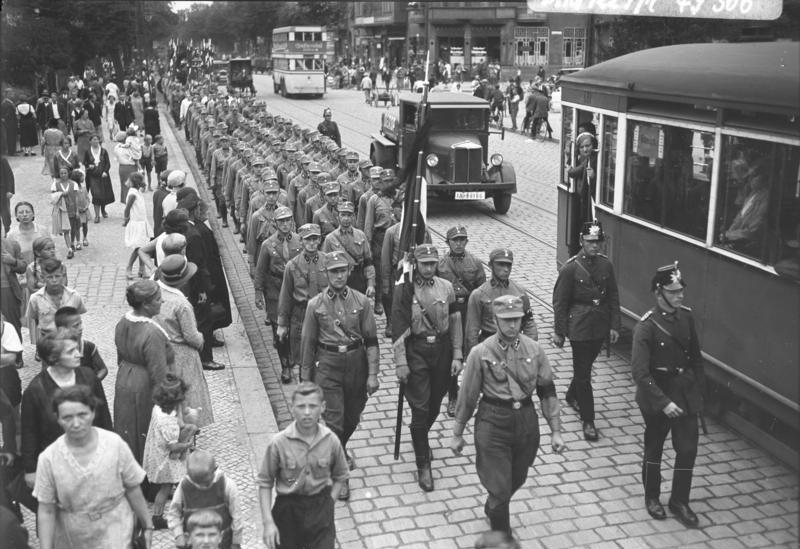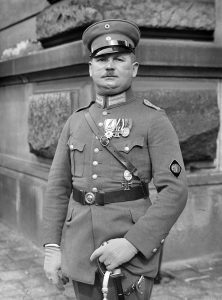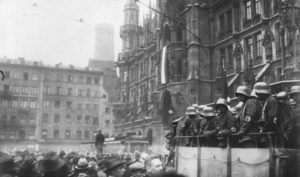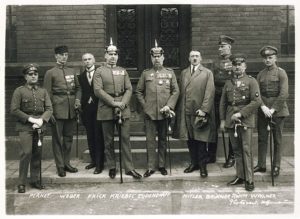On 30 June 1934 Hitler purged his own party of members he feared would become his enemies. Why did this happen? Let’s dive in and find out.
The National Socialist German Workers Party (Nationalsozialistische deutsche Arbeiterpartei Or NSDAP) was formed in the early 1920’s by Adolf Hitler hoping to draw people away from Marxist groups that were attracting many followers. The NSDAP (later to be called simply Nazi) fused elements of Socialism with nationalism creating something similar to what Benito Mussolini did in Italy with Fascism. Both Fascists and Nazis believed in a strong central state, a single party and a strong leader, and that citizens serve the national will in all that they do. They both reject democracy as weak, disdain for civil liberties, and capitalism that seeks profit over that of the state. The agree with Communists and Socialists about the political structure of the state but disagree over nationalism, worker’s rights, and its private ownership. Fascists and Nazis both believe in nationalism as a cornerstone of their ideology, unlike Communists and Socialists who believe they have to be torn down.
Hitler’s party targeted those who felt betrayed by the stinging defeat of World War I. It meant the end of both the German Empire and Austria-Hungary. Austria would be reduced down to its present size of what Austria is today and no longer a major power in the world. On top of that, the hated Versailles Treaty of 1919 levied huge reparations on Germany and stripped her of land and its overseas territories. His party absorbed other parties, some more extreme, as well. Antisemitism would also be a major draw for this party. Many in Germany believed, or were convinced, that Jews had conspired to bring down what happened. Jews owned banks, newspaper and other key businesses were profiteers and grifters who betrayed the German people. It would become a major feature of the party in the years to come.
Inspired by Mussolini’s Black Shirts, Hitler created his own paramilitary called Sturmabteilung (Storm Troops) or SA or simply called Brown Shirts to be used to threaten and intimidate enemies of the party and Germany. It was composed in the early days with war veterans and those that had been members of the Free Corps (Freikorps) which had been formed to counter left wing groups. In 1923 under the leadership of General Erich Ludendorff there was the famous Beer Hall Putsch to seize control of the Bavarian State. It failed and Hitler was imprisoned. While in jail, he composed his seminal book that told the world what his beliefs were and what the Nazi Party would do. Mein Kampf would, when published, become popular reading. It still is today in many parts of the world influenced by elements of fascism and antisemitism.

SA-Propagandamarsch in Spandau
Bundesarchiv, B 145 Bild-P049500 / CC-BY-SA 3.0
German Federal Archives via Wikimedia Commons
The Nazi Party would continue to grow through the 1920’s and as economic conditions got worse, found many willing to hear about rebuilding Germany and tossing out the current ruling elites that had made a mess of things. Mussolini made the same type of appeal much earlier and was swept into power after his march on Rome where the king appointed him prime minister even though there had not been a vote to put his party into full power. The Nazi Party, though it used the SA to bully and intimidate, used the ballot box to gain seats in the Reichstag. By 1928, it had gained lots of members but only held 12 seats. Its support came primarily from those who had served in the war, the disillusioned, and many who felt Germany was on the wrong path. Despite its name of being a worker’s party, most industrial workers were not drawn to Nazis. Hitler was not worried about this as he was building a national movement that would draw people into counter those who feared Communism and Socialism. Nazis used posters, slogans, parades, and other things to convey their message to the masses, which was we are to hear to fix Germany and toss out the weak Weimar government.
By the late 1920’s and early 1930’s, both the Nazis and Communists were popular. Both sought to fix the problems but in strikingly different ways. The SA got more active and soon fights were breaking out in the streets, assassinations were occurring. All of this convinced many that a strong central figure was needed to end the chaos, which was what Hitler sought to achieve. The antisemitic leanings were downplayed in general elections but anyone who attended their meetings knew that hatred of Jews was deeply ingrained in its leadership. In the July 1932 elections they got 37% of the vote and 230 seats in the Reichstag. It was a great victory for Hitler, but the November elections saw their fortunes had dissipated. The Nazi Party lost seats (down to 196) while the Communists gained. The other conservative and moderate political parties did well but no one had a clear majority to govern leaving it without a government for a time. President Hindenburg had defeated Hitler who had run for the same position.
The reasons that the Nazis lost votes has been debated, but by this time the Germany economy seemed better, and the Weimar government looked better as a result. This stung the Nazi leadership because the last thing they wanted was Weimar to stay in power. Hitler and those that supported him worked hard to negotiate with the other conservative parties to gain their support. They appealed to the old military aristocracy, the industrialists, and other leaders they needed to get support from. They played up the fear that the Communists would gain power. Most of the other conservative parties were wary of Hitler and his Nazis but ultimately decided to join with him to create a majority so that government could be formed.
And on 30 January 1933, President Hindenburg appointed Hitler as chancellor. Hindenburg and the others who had allied with him though they could control him. That would prove to be a disastrous miscalculation on their part. Hitler moved quickly to solidify the power of the Nazi party. While technically a coalition government, they quickly began suppressing and abridging press freedoms and individual liberties. All those who opposed the Nazis now had the SA, now part of the government, being given police powers. Jews would be dismissed from government posts. Hitler convinced Hindenburg to dissolve the Reichstag, a clever move so that when elections would be held only his party would be seated. They quickly worked to suppress all other parties except the ones that had supported them.
By 1934 the Nazi’s had swept away the old order and through elections (which in many cases were fraudulent) got all the seats they needed to fill the Reichstag. Things looked good but there were some problems. Internal corruption was an issue but so was the issue of continued violence the SA was doing. The SA, like the Black Shirts, served a vital role but also tended to be more purist about their doctrines than most in the party were. The SA had swelled in size to 4.5 million making it a very large paramilitary organization. As revolutionaries know, the greatest threat is not from outsiders but from those inside who build powerful groups internally that might topple ?you. Stalin had purged most of the early revolutionaries because they wanted more radical ideas and threatened his power. Mussolini had issues. Now Hitler was facing it as well.
The German army also was worried. There was a fully armed paramilitary organization that ran parallel to it. That would inevitably cause friction, especially in times of war when you needed clear operational structures. The SS, by contrast, was both a bodyguard for Hitler and oversaw the administration of specific areas designated to them by Hitler. They did not act as a paramilitary organization. Also, the public began to complain as well. That seems odd in a dictatorship they would care about public opinion, but the Nazis knew if they lost support of the populace, it would be an even bigger issue to contend with. The violence of the SA was getting loud feedback from the local Nazi leaders. In short, it had to be curtailed. Some saw its leader Ernst Rohm as the German equivalent of the Roman Sejanus who had become very powerful under Emperor Tiberius and threatened his reign. Both Himmler and Goering played on this fear when trying to convince Hitler that its leader, Ernst Röhm, was planning a coup.

And so, on the night of 30 June 1934, called the Night of the Long Knives came about. Rohm and all the leaders of the SA were arrested and ultimately executed (often brutally). Nazis took advantage of this event to also to eliminate other political opponents including former chancellor Kurt von Schleicher.
Aftermath
The SA was downsized and a new leader, Viktor Lutze, was appointed as Stabschef (the equivalent of chief of staff) to the SA. The SA would continue to be used to go after those opposing Hitler and later the Jews. The SA was used in Kristallnacht in November 1938 to destroy over 7,500 glass storefronts on Jewish shops and businesses along with ransacking Jewish homes. The also helped destroy nearly all the Jewish synagogues (the only ones that were spared were ones next to important buildings-they could be ransacked but not burned). The SA also carried out mass beatings of Jews and arrested many who were taken to concentration camps. They became overshadowed by the SS that now handled policing and security. By
1939 it had lost significance in the Nazi Party. It was converted into a training school for the armed forces. Once war began, it lost its members to the Wehrmacht (German armed forces). It continued to exist though and when the SS and the Foreign Office had major issues, he appointed SA members to diplomatic posts to counter the SS. When Lutze died in a car accident in 1943, the new leader tried to smooth out the tensions between the SS and the SA. The SA would formally cease to exist when the war ended in 1945.
Sources
Mullen, M. (2021, June 28). Hitler purges members of his own Nazi party in Night of the Long Knives. HISTORY. https://www.history.com/this-day-in-history/night-of-the-long-knives
The Night of Long Knives – The Holocaust Explained: Designed for schools. (1933, June 22). https://www.theholocaustexplained.org/the-nazi-rise-to-power/how-did-the-nazi-gain-power/night-of-long-knives/
The SA. (n.d.). https://encyclopedia.ushmm.org/content/en/article/the-sa
Suggested Reading
Allen, W. S. (1984). The Nazi seizure of power: The Experience of a Single German Town, 1922-1945. Franklin Watts.
Engelmann, B. (1986). In Hitler’s Germany: Daily Life in the Third Reich. Pantheon.
Shirer, W. L. (2011). The rise and fall of the Third Reich: A History of Nazi Germany. Simon and Schuster.
Titanic News Channel is a participant in the Amazon Services LLC Associates Program, an affiliate advertising program designed to provide a means for sites to earn advertising fees by advertising and linking to Amazon.com.












